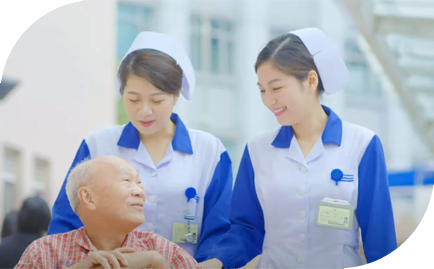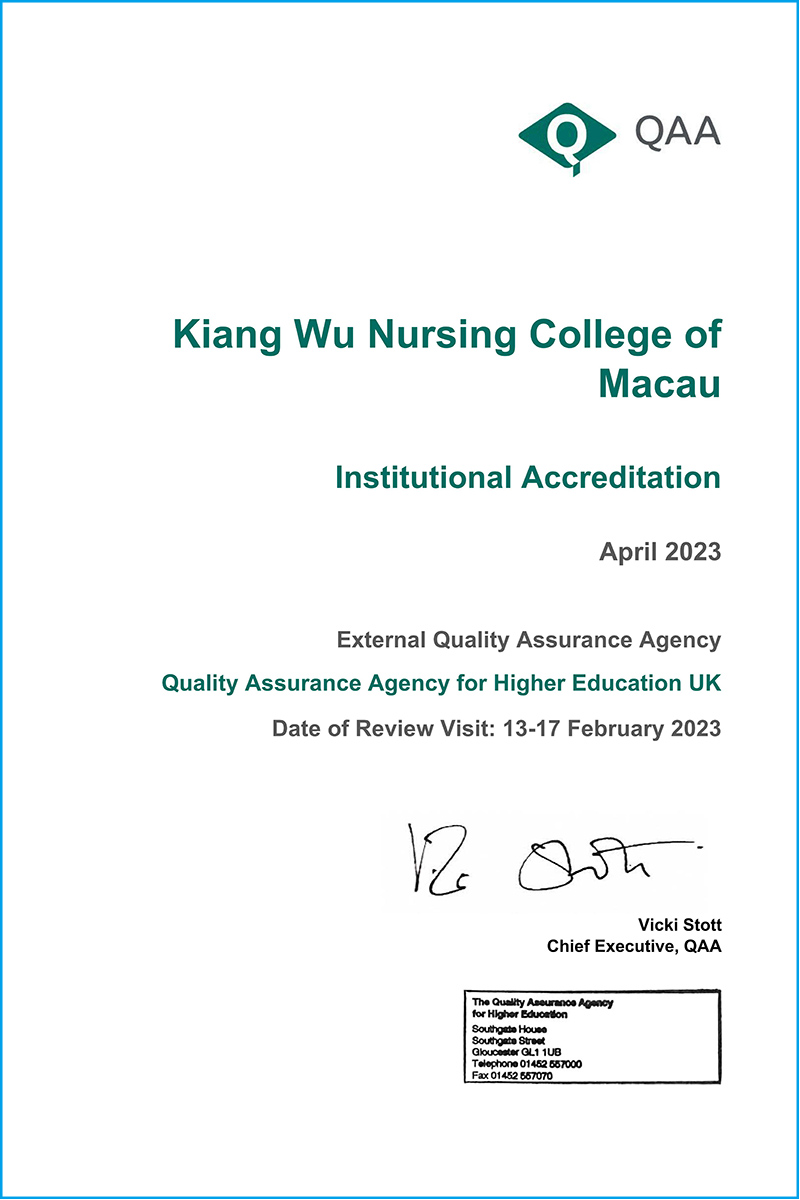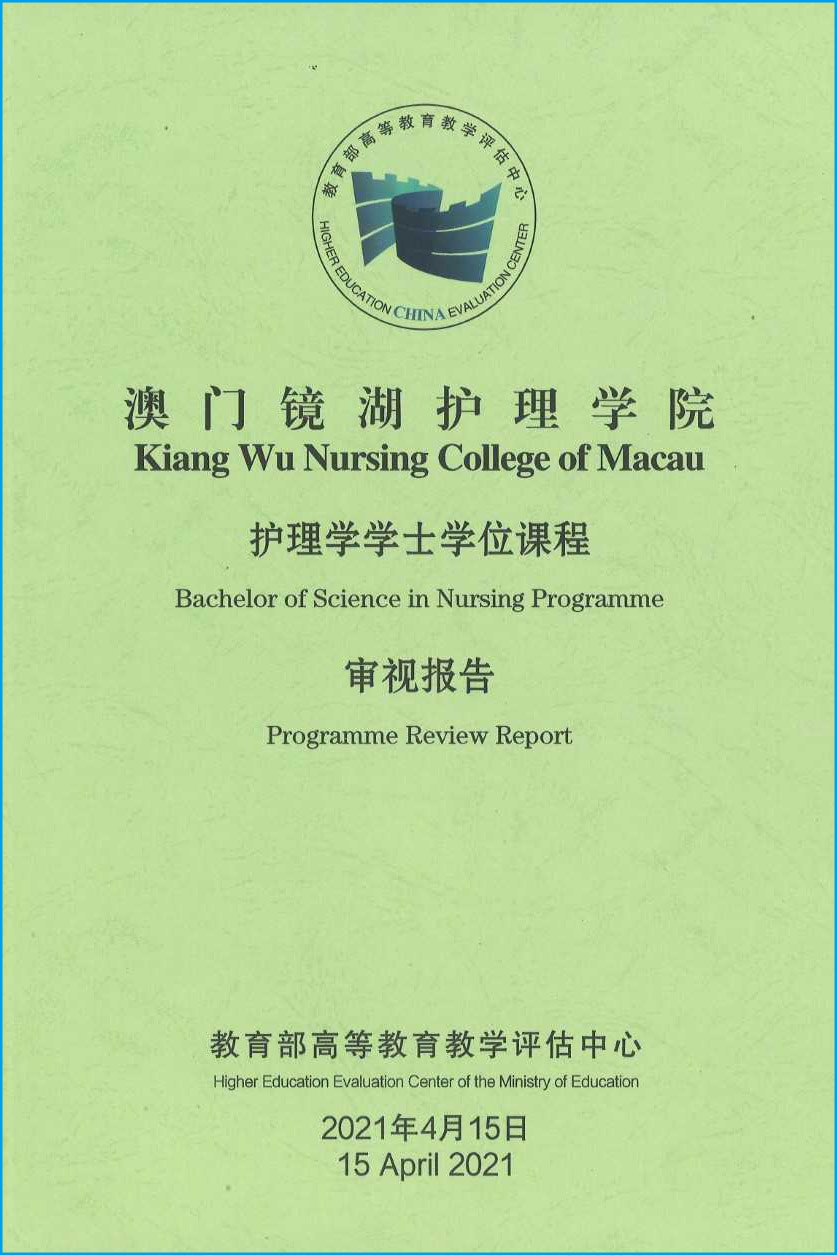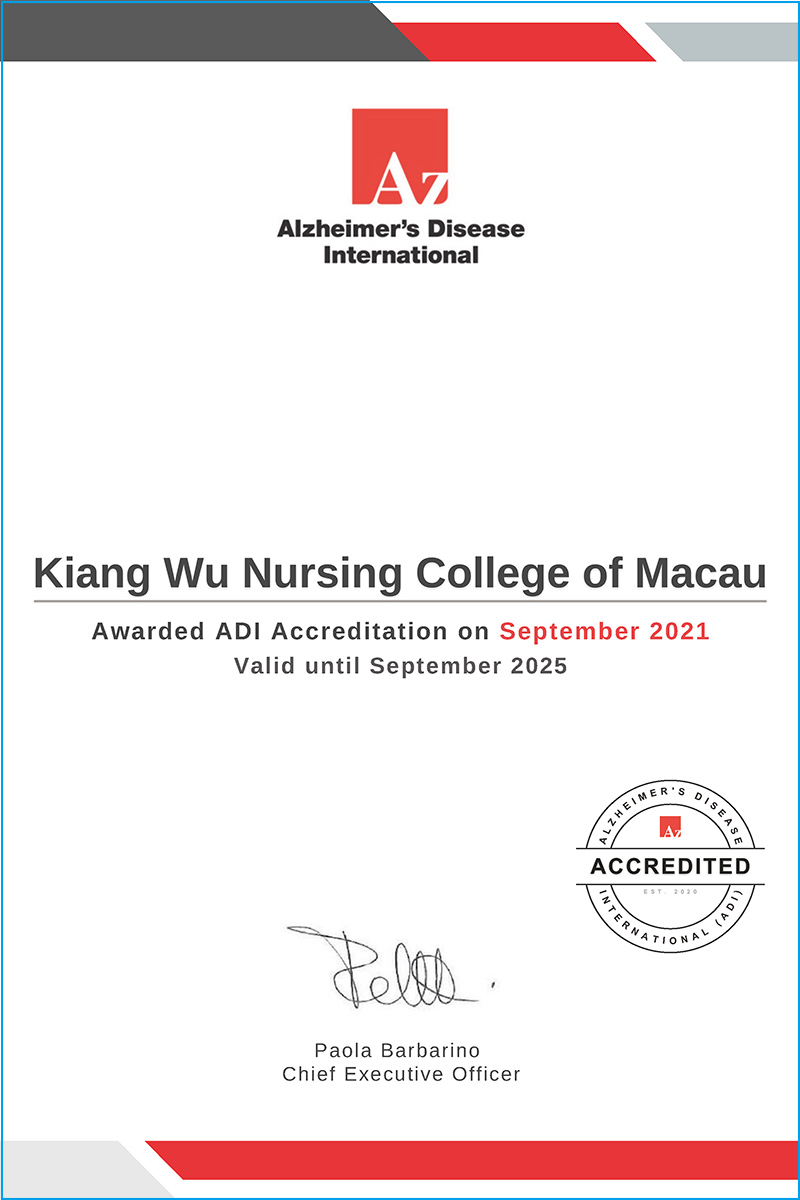Ten-Year Plan
1. The nature and history of the College
Established in 1923, Kiang Wu Nursing College of Macau (KWNC), hereinafter referred to as the College, is a subsidiary of the Kiang Wu Charitable Association (KWCA), it is also a non-profit higher education institute. Inheriting the spirit of Dr. Sun Yat-sen and Kiang Wu, more than 3,000 nursing graduates have been trained. Currently, about 70% of the in-service nurses in Macao have been graduated from the College. For a century, the College has been constantly seeking changes and keeping abreast with the times and developed from secondary vocational education to higher education. In 1997, higher nursing education courses were launched. On 5th November 1999, it was renamed from Kiang Wu Nursing and Midwifery School to Kiang Wu Nursing College of Macau. In 2002, the College launched Macao's first four-year nursing bachelor's degree programme, in 2018, Macao's first college-level master's degree programme was successfully established. In May 2022, KWCA and the Education and Youth Development Bureau (DSEDJ) signed the 'Facility Rental Agreement' for the new campus in Islands District Medical Complex. At the same year, the College relocated from the Cheng-Kai Memorial Hall in Kiang Wu Hospital and the Mong Ha Campus of Macao Daily building to the new campus to educate students.
Since the handover of Macao to the Motherland in December 1999, the College has evolved from offering one nursing programme to offering/co-operating a wide range of higher education programmes including master's degrees, bachelor's degrees and post-degree diplomas/certificates; starting with only master's level teachers, the College will have a team of more than 60% of teachers with doctoral degree and experience in teaching in the nursing profession and other related professions by September 2022. In the future, under the new higher education and subsidy policies of the Macao SAR Government, as well as the relocation to new neighborhoods and teaching venues, the College will continue to adjust its development strategies to embark on its second hundred years of existence, building on the foundation of its first century of operation.
Since the handover of Macao to the Motherland in December 1999, the College has evolved from offering one nursing programme to offering/co-operating a wide range of higher education programmes including master's degrees, bachelor's degrees and post-degree diplomas/certificates; starting with only master's level teachers, the College will have a team of more than 60% of teachers with doctoral degree and experience in teaching in the nursing profession and other related professions by September 2022. In the future, under the new higher education and subsidy policies of the Macao SAR Government, as well as the relocation to new neighborhoods and teaching venues, the College will continue to adjust its development strategies to embark on its second hundred years of existence, building on the foundation of its first century of operation.
2. The College's Development Strategy from now until 2030
2.1 Expand student recruitment, offer diversified courses, and improve operational level
Over the years, the College has been in line with the SAR Government's philosophy of governance and health policy, and the number of students enrolled, and the types of programmes offered have been increasing year by year. 2022-2023 academic year onwards, the College has increased the number of student intake in response to the Government's enrolment requirements, with the number of student places in the Bachelor of Science in Nursing Programme (BSN) expanding from 120 to 180, and that of student places in the Master of Nursing Programme (MN) increasing from 40 to 60 , and a feasible matching programme was established for the purpose of recruiting more students. The total number of new students was 203, including 168 BSN students and 35 MN students. In 2023, the College plans to offer five to nine higher education programmes, increasing the number of students from 510 in 2020 to 540 in 2023. In addition to the two major programmes mentioned above, the College also plans to offer a Doctor of Philosophy (Nursing) (PhD), to organize a joint PhD programme with the School of Nursing Peking Union Medical College, to launch the Joint Talent Training Programme between Universities/Institutions in the Greater Bay Area, to launch a 2+2 Bachelor of Nursing programme in collaboration with Guangzhou Medical University, and to launch a Sino-foreign collaborative Master of Nursing Programme with the Hunan Normal University, etc.
In the 2024-2025 academic year, the College plans to offer nine types of programmes for nearly 800 students, including the upgrading of the existing post-degree diploma level to the Master of Advanced Nursing Practice (MANP), the post-degree certificate level to the Master of Applied Gerontology (MAG), after 2025, the Master of Health Services Management (MHSM), which will be taught in English, and a Doctor of Philosophy (Nursing) (PhD) is planned for the 2027-2030 academic year. The ratio of undergraduate to postgraduate students will gradually increase from the current 7.3:1 to 2.8:1 in the 2029-2030 academic year.
In terms of non-higher education, in addition to the existing programmes, a series of CPD programmes for healthcare professionals will be launched in line with the requirements of the CPD credits under the Macao Healthcare Personnel Registration System (Health Professions Council of the Government of the Macao Special Administrative Region, 2021).
Student and Programme Development Scale of 2020-2030:
In the 2024-2025 academic year, the College plans to offer nine types of programmes for nearly 800 students, including the upgrading of the existing post-degree diploma level to the Master of Advanced Nursing Practice (MANP), the post-degree certificate level to the Master of Applied Gerontology (MAG), after 2025, the Master of Health Services Management (MHSM), which will be taught in English, and a Doctor of Philosophy (Nursing) (PhD) is planned for the 2027-2030 academic year. The ratio of undergraduate to postgraduate students will gradually increase from the current 7.3:1 to 2.8:1 in the 2029-2030 academic year.
In terms of non-higher education, in addition to the existing programmes, a series of CPD programmes for healthcare professionals will be launched in line with the requirements of the CPD credits under the Macao Healthcare Personnel Registration System (Health Professions Council of the Government of the Macao Special Administrative Region, 2021).
Student and Programme Development Scale of 2020-2030:
|
Year
|
(1st-3rd Year)
2020-2023 |
(3rd-5th Year)
2023-2025 |
(5th-7th Year)
2025-2027 |
(7th-10th Year)
2027-2030 |
||||
|
Programme &
No. of Students (Higher Education) |
5-7 types of programme
|
7-9 types of programme
|
7-10 types of programme
|
10-12 types of programme
|
||||
|
BSN
|
420-440
|
BSN
|
480-600
|
BSN
|
480-600
|
BSN
|
480-600
|
|
|
Collaborative
Programmes
|
(15-20)
|
2+2 Programmes
|
(20-30)
|
2+2 Programmes |
(20-30)
|
2+2 Programmes
|
(20-30)
|
|
|
MN
|
50-60
|
MN | 80-120 | MN | 80-120 | MN | 120 | |
| Sino-foreign cooperation | (0) | Sino-foreign cooperation | (30-60) | Sino-foreign cooperation | (60) | Sino-foreign cooperation | (60) | |
| PDAN |
10
|
MANP | 16 | MANP | 16 | MANP | 16 | |
| MAG | 20 | MAG | 30 | MAG | 30 | |||
| PhD | 4-6 | MHSM | 20 | MHSM | 20 | |||
| PhD | 6 | PhD | 6-8 | |||||
| DNP | 20 | |||||||
|
Certificate/
Diploma |
30
|
Certificate/
Diploma |
30
|
Certificate/
Diploma |
40
|
Certificate/
Diploma |
50
|
|
|
Undergraduate to
postgraduate ratio |
7.3 : 1
|
3.7 : 1
|
3.1 : 1
|
2.8 : 1
|
||||
|
Total No. of Students
|
510 - 540
|
630 - 792
|
672 - 832
|
742 - 864
|
||||
|
Programme &
No. of Students (Non-Higher Education) |
Certificate/Diploma/
CPD/Joint Programme 1,000 |
Certificate/Diploma/
CPD/Joint Programme 1,200 |
Certificate/Diploma/
CPD/Joint Programme 1,500 |
Certificate/Diploma/
CPD/Joint Programme 1,800 |
||||
2.2 Ensure that the governance of the institution and the quality of its programmes meet regionally and internationally recognized standards through quality accreditation
By August 2022, the College has met the target of 50% of programme validation in the first cycle of higher education institutions under Administrative Regulation 17/2018 [Higher education quality assessment regime] and plans to complete 100% of programme validation by 2025, as required by law. The College will invite QAA to conduct institutional accreditation in early 2023 to confirm the quality of the College's governance and programmes in accordance with regionally and internationally recognized standards. Based on the development needs, this accreditation application will be made for the subject areas of Health and Welfare, and at the same time for the Doctor of Philosophy (PhD) programme, so that the qualification of Doctor of Philosophy (Nursing) (PhD) will be eligible to offer its own programme, and that the original Master of Nursing Programme (MN) will undergo a programme review.
2.3 Develop Integration of Teaching, Research and Social Service
With the increase of research output and the needs of future development, the College has adjusted the position from 'teaching-oriented and research-assisted' in the past 10 years to 'teaching-oriented, develop teaching and research simultaneously'. With the integration of teaching, scientific research and social service as the policy, and the support from the Research Management and Development Department and Nursing & Health Education Research Centre, KWNC has encouraged teaching staff to conduct research collaborating with local and Guangdong-Hong Kong-Macao Greater Bay Area professionals. KWNC has also used relevant research output to carry out evidence-based clinical and community services and has taught courses at various levels to cultivate talents to contribute back to the society.
2.4 Building a Caring and Sustainable Campus
In order to support the teaching and research activities of teachers and students, the first phase of the campus strives to achieve 1. full functionality; 2. convenient transportation; 3. unobstructed access to information and communication systems; and 4. reserved space for sustainable development, so that it can become a caring and sustainable island complex campus will be built as a direction of the permanent campus. In line with the above objectives, the new campus of the College, to be built next to the Island Hospital and in the vicinity of the Guangdong-Macao in-depth cooperation zone, will have the external conditions to facilitate professional learning, academic exchanges, and community services for the faculty and students. The new campus will be closely connected to the hospital and the neighboring community and will progressively promote the concept of "open campus" to ensure communication and close collaboration between the College and the community. The new campus will continue to optimize and improve the software and hardware construction and related management systems of teaching facilities such as the library, the information centre, the professional competence training centre, the nursing laboratory, the nursing and health teaching and research centre, and the life experience centre, etc. It will also set up databases of relevant information and incorporate the basic data of various types of management into the platform of the information system in order to tie in with the construction of the smart campus. The new campus will gradually implement electronic management, standardize the management methods for information security, housing and buildings, public facilities, campus environment, and gardening and greening, and implement construction, maintenance and management in accordance with the requirements of the relevant laws and regulations. At present, more than 100 students have applied for dormitory accommodation. The College manages the buildings together with the government departments that temporarily share the floors, and some of the public facilities are managed and maintained by outsourced companies.
2.5 Speed up regional cooperation and process towards internationalization
In the next five to 10 years, with the encouragement of the nation's development strategies, the College will make headway to intensify the Guangdong-Macao cooperation, will utilize the advantages of teaching resources and disciplines, will develop a nursing and health teaching and research base with the characteristics of Macao and Kiang Wu, will promote cross-regional teaching and research cooperation. On the basis of the gradual increase of students and programmes, the College will strongly promote international exchanges and cooperation, will expand, and deepen cooperation with organizations that KWNC has been collaborating with, will broaden the international vision and cross-cultural communication skills of teachers and students.
3. Goals in Eight Areas
According to the five major development strategies mentioned above, KWNC formulated the goals and measures in the following eight aspects:
3.1 Academic and profession development
| ‧ | Strengthen the quality assurance culture, comprehensively promote the evaluation system, and comprehensively ensure the quality of higher education. |
| ‧ | Strive for more college-running resources and enhance academic influence. |
| ‧ | Develop a unique BSN programme. |
| ‧ | To establish higher-level postgraduate education, offer/jointly offer postgraduate programmes such as Doctor of Philosophy, master's degree, certificate, and diploma programmes, etc. |
| ‧ | According to the academic and talent advantages of the College, continue to focus on senior care as the key point of development. |
| ‧ | Develop online teaching and online courses. |
| ‧ | Promote the coordinated development of higher education and non-tertiary education courses. |
| ‧ | By 2025, to complete the quality assessment work according to the requirements of the legislation of Macau on higher education. |
| ‧ | By 2025, 7-9 types of programmes will be offered, with no less than 650 students in higher education and a ratio of undergraduates to postgraduates of 3.7:1. |
| ‧ | By 2030, there will be 12 types of higher education programmes with a minimum of 800 students and a ratio of 2.8:1 between undergraduate and postgraduate students. |
3.2 Personnel Development
| ‧ | Strive to cultivate a diversified team of teachers with 'From Personhood to Benevolence' spirit and professional and academic abilities. |
| ‧ | Based on three research groups, cultivate subject leaders. |
| ‧ | Cultivate a team of teachers who are good at teaching with multiple disciplines. |
| ‧ | Create different titles from lecturer to professor, and to have a reasonable combination of full-time and part-time teachers, and teachers with PhD and master's. |
| ‧ | By 2023, there will be 43 teachers. To build up a team with a reasonable combination of lecturers to professors, full-time and part-time, PhD and Masters teachers. |
| ‧ | Increase the proportion of professors and associate professors from 30% to about 37%, and the proportion of senior technical staff from the current 33% to 50% by the 2025-2026 academic year. To employ 70% of teachers with doctoral degrees. |
| ‧ | By 2030, the number and qualification of staff will be able to increase in line with the development of student numbers and programmes, with the proportion of doctoral degree holders above 80%, which is close to the level of top universities in Asia. |
3.3 Research Development
| ‧ | Expand research and development direction of the College (three domains: adult and senior research, children and teenager and community, nursing, and nursing education), Improve the academic level of the faculty team, optimise master's programmes, and offer doctoral training. |
| ‧ | Carry out high-quality research projects to promote service quality and profession development. |
| ‧ | Leveraging the transfer of research results to increase social benefits, with two products successfully applied for patents by the 2025-2026 academic year and three more by 2030. |
| ‧ | Strengthening teaching and research staff's research and publication platform, with 60% of teachers participating in research projects and 30% of articles published in Q1 journals of nursing or health sciences by 2025-2026 academic year, in order to increase the quantity and quality of research outputs. |
| ‧ | By 2030, 70% of teachers to participate in research projects and more than 50% of articles to be published in nursing or health science Q1 journals. |
| ‧ | Promote research output to become guidance for related health policies (such as senior health, nursing education, life, and death education, etc.). |
| ‧ | Expand the support of research funds in the society. |
| ‧ | Promote and manage academic publishing of the College. |
| ‧ | Establish Healthy Ageing Research Centre under the Nursing & Health Education Research Centre to strengthen the advantages of the College. |
3.4 Student development and cultivate nursing and health science talents
| ‧ | Integrate official curriculum and non-official curriculum to have people-centred concepts throughout, strengthen students' understanding of the world, growing sense of national identity, social responsibility and cultivate, nursing and caring abilities |
| ‧ | Provide students with professional education while also offer holistic education and general education, therefore students can become nursing talents with caring ability and good character |
| ‧ | Let students learn professional knowledge through social service, and practice, and have a whole-person development in body, mind, social and spirit |
| ‧ | Cultivate Multi-profession and Multidisciplinary talents, stay abreast of the times, therefore they can utilise their knowledge gained |
| ‧ | Develop students' ability to cope with Macao public registration examination and placement |
| ‧ | Strive for more social resources to support students in joining the nursing profession |
| ‧ | Let students from outside of Macao adapt to life and study on campus and in Macao |
3.5 Academic and professional support
| ‧ | According to the programme and student development plan, provide a comprehensive learning environment and resources to student of various levels and different majors. |
| ‧ | Construction of the new campus of the Islands District Medical Complex as planned: - Construction and development of the Life Journey Experience Pavilion. - Objective Structured Clinical Examination Centre (OSCE). - Organizing the construction of an online academy. - Enhancement of Smart Campus. - Continuous improvement of hardware and software for a safe, healthy and environmentally friendly campus. |
| ‧ | Provide continuing education for health care professionals. |
| ‧ | Strengthen the cost-benefit calculation of various teaching and research activities of the college, to ensure that KWNC operating funds can support developmental needs. |
| ‧ | By 2025, the number of clinical teaching bases will increase from 29 to 35; the investment in libraries and teaching facilities and equipment will be maintained at 5% of the total expenditure of the College. |
| ‧ | By 2030, the investment in libraries, teaching facilities and equipment will increase to 8% of the total expenditure of the College. |
3.6 Expand and optimise the source of students
| ‧ | Expand and optimise the source of students as planned |
| ‧ | Maintain a reasonable and comparable teacher-student ratio with similar local schools |
| ‧ | In 2025, the total number of students in higher education programmes will not be less than 650. The total number of students in higher education programmes should not be less than 800 by 2030. |
| ‧ | 1,200 students in non-higher education programmes by 2025. By 2030, the number of students of non-higher education programmes will reach 1,800. |
| ‧ | Expand the diversify source of students inside and outside of the nation. |
| ‧ | Implement Biliteracy and Trilingualism as the medium of instruction system in various programmes and strengthen the proportion of English as the medium of instruction in BSN and various programmes. |
| ‧ | Strengthen tracking and contacting graduates and have regular communication with them. |
3.7 Combination of teaching, scientific research, and social services
| ‧ | Strengthen the development of Nursing & Health Education Research Centre, use the centre's platform, and the Life Journey Experience Pavilion and other facilities to promote the integration of teaching, scientific research, and social services. |
| ‧ | Use 'Problem Solving for Better Health(PSBH)' project in the BSN Programme and various teaching and research activities for promotion. |
| ‧ | Run and develop the Life Journey Experience Pavilion, support the teaching of all levels and various subjects, and gradually develop related social services. |
| ‧ | By 2025, two projects will be successfully established. 2025-2030, three projects in five years will apply for external funding and will be successfully established. |
| ‧ | 15 teaching and research staff to serve as external professional advisors or members of professional advisory committee by 2025 and up to 20 members by 2030. |
| ‧ | Cooperate with community organisations to teach and research during the process of providing social services. |
| ‧ | Utilise the geographic advantage of the new campus to encourage cooperation with new communities or cities in the Greater Bay Area. |
3.8 Regional and International Cooperation
| ‧ | Maintain close contact and cooperation with organisations that the College has signed contracts with |
| ‧ | Let students gain cross-cultural learning experiences |
| ‧ | Create an international learning environment |
| ‧ | To build two nursing and health teaching and research bases in the Guangdong, Hong Kong and Macao Greater Bay Area under the brand name of the College by 2030. |
| ‧ | To increase the ratio of overseas students from 13% to 15% by 2025. Maintain 100% of undergraduate students' clinical internships in Mainland China and increase the number of internship hours from 20% to 22%. 10% of undergraduate students will go on exchange programmes in Taipei, Taichung, Hualien, Hong Kong, Singapore, Melbourne, Lisbon, Coimbra and Belgium. |
| ‧ | To recruit 5 international students by 2030, with the proportion of overseas students reaching 20%. 100% of undergraduate students will spend 25% of their clinical internship hours in Mainland China. 15% of undergraduate students will spend 2 weeks or more on clinical exchange programmes in Taipei, Taichung, Hualien, Hong Kong, Singapore, Lisbon, Coimbra and Belgium. |
4. Islands District Medical Complex Campus Building, Financial Management & Overall Development of the College
To coordinate with the Macao SAR Government policy, the College has expanded its scale to meet the future social development requirements. The Government rents out the Islands District Medical Complex nursing teaching building as a venue for higher education activities for the College which is a subsidiary of the Kiang Wu Charitable Association. The Main Campus is still the permanent campus of the College, and it is expected that the new campus in the Islands District Medical Campus will also become a permanent campus for development. Several floors of the nursing teaching building of the Islands District Medical Complex are used by the Government. The available area for the College's usage is more than double of the total area of the current two campuses. The per-student area has increased from 17.5 square meters in the Main Campus to 31.4 square meters. There are a total of 130 hostel places for male and female students and 12 teachers' flats. The new campus building will reflect the characteristics of nursing care; therefore the whole campus can have the 'people-oriented', 'safety and healthy', 'energy saving and environmental protection' concepts, modern educational notions, and information technology elements.
The daily financial management of the College is managed jointly by the College leaders and the College Council and is accountable to the Chair of the College Council/Kiang Wu Charitable Association. The College Council audits the College's accounts every year. The annual appropriation of the Government has always been the main source of funding for the College. In terms of tuition fee income, the gradual increase in the number of programmes offered, the increase in the number of students and the increase in tuition fees from the 2021-2022 academic years have increased the financial income of the College. In the future, the source of funding for the College will still be based on the Government's annual appropriation, tuition revenue and the provision of nursing professional knowledge services, also the College will strive to raise other revenue.
The daily financial management of the College is managed jointly by the College leaders and the College Council and is accountable to the Chair of the College Council/Kiang Wu Charitable Association. The College Council audits the College's accounts every year. The annual appropriation of the Government has always been the main source of funding for the College. In terms of tuition fee income, the gradual increase in the number of programmes offered, the increase in the number of students and the increase in tuition fees from the 2021-2022 academic years have increased the financial income of the College. In the future, the source of funding for the College will still be based on the Government's annual appropriation, tuition revenue and the provision of nursing professional knowledge services, also the College will strive to raise other revenue.
Strive for Competence and Integrity
Serve with Professionality and Care
Contact Us




 Tel: (853) 8295 6200
Tel: (853) 8295 6200 Fax: (853) 2836 5204
Fax: (853) 2836 5204 Email: admin@kwnc.edu.mo
Email: admin@kwnc.edu.mo
Institutional Accreditation (IA) &Nursing Education Accreditation
 |
 |
 |
| The Quality Assurance Agency for Higher Education (QAA): Institutional Accreditation |
The Motherland's Education Quality Evaluation Agency of the Ministry of Education:
Nursing Education Accreditation |
Course provider of Alzheimer's Disease International (ADI) |
Copyright © 2024 KIANG WU NURSING COLLEGE OF MACAU










